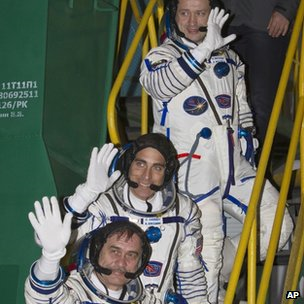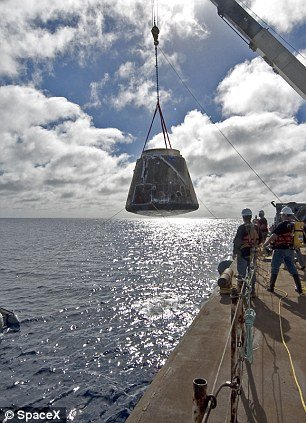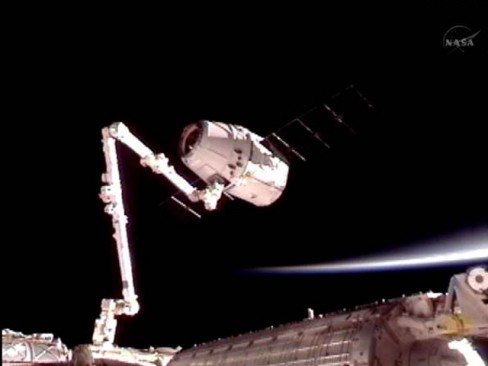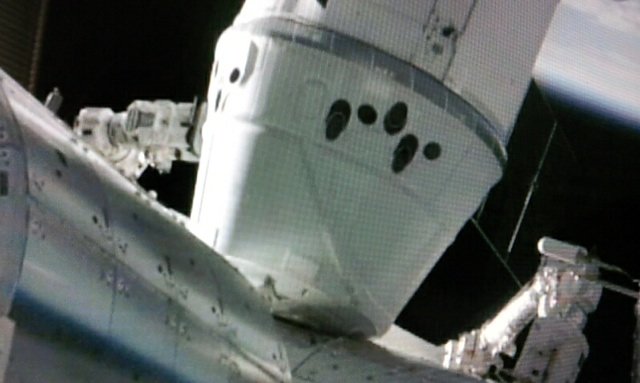Home Tags Posts tagged with "space station iss"
space station iss
Soyuz spacecraft has docked at the International Space Station (ISS) after a journey of less than six hours.
The three-man crew is the first to take the quicker route, involving just four orbits.
The journey normally takes two days for a Russian spacecraft.
The arrival of Russians Pavel Vinogradov and Alexander Misurkin and Chris Cassidy of the US brings the number of crew at the ISS to six.

Soyuz spacecraft has docked at the ISS after a journey of less than six hours
The crew launched from the Baikonur Cosmodrome in Kazakhstan.
After lift-off at 20:43 GMT, the Soyuz capsule then entered orbit and, using intricate ballistics manoeuvres, succeeded in cutting out around 30 orbits and 45 hours from the flight time to the ISS.
Prior to the flight, the shortened route had been successfully tested three times by Russian Progress cargo ships, which are unmanned versions of the Soyuz that transport supplies to the ISS.
The three new arrivals are due to return to Earth in September. The other three members of the ISS crew arrived in December and will leave in May.
Over the next six months the crew will perform 137 investigations on the US operating segment of the station, and 44 on the Russian segment, according to a statement from the US space agency, NASA.
NASA said that the investigations will cover human research, biological and physical sciences, technology development, Earth observation, and education.
[youtube xx_0Sq55NVs]
NASA is to test color-changing lights on the International Space Station (ISS) as part of efforts to help astronauts on board sleep.
The US space agency will initially swap a fluorescent panel with a solid-state lighting module (SSLM) containing LEDs which produces a blue, whitish or red-colored light depending on the time.
It says the move may help combat insomnia which can make depression, sickness and mistakes more likely.
The test is due to take place in 2016.
News site Space.com reported that the equipment is being made by Boeing and the project has an $11.2 million budget.
Studies on Earth suggest humans and other creatures follow what is known as a circadian rhythm – a 24-hour biological cycle involving cell regeneration, urine production and other functions critical to health.
Research indicates that it is regulated by a group of cells in a portion of the brain called the hypothalamus which respond to light information sent by the eye’s optic nerve, which in turn controls hormones, body temperature and other functions than influence whether people feel sleepy or wide awake.
The aim of the experiment is to simulate a night-day cycle to minimize sleep disruption caused by the loss of its natural equivalent on the station.

NASA is to test color-changing lights on the ISS as part of efforts to help astronauts on board sleep
When the SSLMs are colored blue the aim is to stimulate melanopsin – a pigment found in cells in the eye’s retina which send nerve impulses to parts of the brain thought to make a person feel alert.
Blue light is also believed to suppress melatonin – a hormone made by the brain’s pineal gland which makes a person feel sleepy when its levels rise in their blood.
By switching from blue to red light – via an intermediary white stage – this process should be reversed, encouraging a feeling of sleepiness.
NASA has previously warned sleep problems among its crews on other missions were also common.
“On some space shuttle missions up to 50% of the crew take sleeping pills, and, over all, nearly half of all medication used in orbit is intended to help astronauts sleep,” it said in 2001.
“Even so, space travellers average about two hours sleep less each night in space than they do on the ground.”
Derk-Jan Dijk, professor of sleep and physiology at the University of Surrey, said NASA’s test reflects the latest findings closer to home.
“It hasn’t been until recently that we started to realize that artificial light, as we see it or are exposed to it in the evening, will have an effect on our alertness and subsequent sleep.
“It turns out there are receptors in the eye which are tuned toward blue light. Adding blue light to artificial lights visible during the day can actually help us to be alert, but if there is too much blue light in the artificial lights at night that may disrupt sleep.
“So, varying the spectral composition of light does make sense from a circadian perspective, and better regulating artificial sleep-wake cycles may indeed benefit astronauts’ sleep in space.”
NASA adds there could be spin-off benefits for the population at large.
“A significant proportion of the global population suffers from chronic sleep loss,” said Daniel Shultz at the Kennedy Space Center.
“By refining multipurpose lights for astronauts safety, health and well-being in spaceflight, the door is opened for new lighting strategies that can be evolved for use on Earth.”
Russian spacecraft Soyuz TMA-05M carrying a three-man crew has blasted off for the International Space Station (ISS).
The Soyuz rocket set off from Kazakhstan at 02:40 GMT on Sunday with Russian, Japanese and American astronauts on board.
They are set to dock with the ISS, a $100 billion research complex orbiting around 385 km (240 miles) above Earth, early on Tuesday.
NASA said the Soyuz TMA-05M rocket had a “smooth ride into space”.

Russian spacecraft Soyuz TMA-05M carrying a three-man crew has blasted off for the International Space Station
The astronauts on board, veteran Russian cosmonaut Yuri Malenchenko, NASA’s Sunitia Williams and Japanese astronaut Akihiko Hoshide will join three others on board the ISS.
NASA flight engineer Joseph Acaba and Russian cosmonauts Gennady Padalka and Sergei Revin are already living aboard the space station, which is set to receive an unprecedented level of traffic over the next few weeks.
According to the Associated Press news agency, a Japanese cargo ship will dock with the station next week, followed by a further eight craft making contact with the orbiting satellite.
NASA ended its space shuttle programme in July 2011, and since then US astronauts have depended on Russian Soyuz flights for transport to reach the International Space Station.
[youtube zqDZAYUT34E]
SpaceX Dragon cargo capsule has splashed down in the ocean off the California coast.
The return to Earth completes a historic first mission to the International Space Station (ISS) by a privately operated vehicle.
Impact with the water was confirmed at 08:42 Pacific Daylight Time.
Fast boats positioned in the splashdown zone were despatched to recover the unmanned capsule.
Early data suggested Dragon came down very close to its targeted location about 900 km (560 miles) from the Baja Peninsula.
The mission was intended as a demonstration of the freight service SpaceX plans to run to the platform.

SpaceX Dragon cargo capsule has splashed down in the ocean off the California coast
It took half a ton of food and supplies up to the ISS astronauts, and brought down about two-thirds of a ton of completed experiments and redundant equipment.
A successful recovery of the capsule and its contents will trigger a $1.6bn (£1bn; 1.3bn-euro) contract with the US space agency (NASA) for 12 further re-supply trips.
Dragon’s fall to Earth was overseen by controllers at SpaceX’s headquarters in Hawthorne, California, and at NASA’s Johnson Space Center in Houston, Texas.
The journey home began early on Thursday when the vessel was unberthed from the ISS by the station’s 17.5 m (58 ft) robotic arm.
Astronaut Don Pettit, at the controls of the Canadarm2, then released the cargo ship to fly free at 09:49 GMT, just as the station was moving over the Southern Ocean.
Dragon fired its thrusters three times to take itself down and away from the platform. A final 10-minute burn some five hours later committed the capsule to a plunge into the atmosphere.
A range of ships and planes had been organized to track the return, which was slowed in the final minutes by three parachutes.
Once recovered, Dragon will be returned to port, and then transferred to Texas for inspection and for its cargo to be unloaded.
NASA has engaged SpaceX (Space Exploration Technologies Corporation) and another company, Orbital Sciences Corporation of Virginia, to fulfill logistics roles at the ISS.
The agency hopes the contracting out of freight duties will save it money that can then be re-invested in more daring activities beyond the station, at destinations such as asteroids and Mars.
The commercial cargo approach will be followed later this decade by crew transport services.
SpaceX wants this business as well, and is developing the safety and life-support equipment that would allow Dragon to double up as an astronaut taxi.
SpaceX cargo capsule Dragon returns to Earth on Thursday having spent a week attached to the International Space Station.
The unmanned vehicle will fall through the atmosphere to make a splashdown in the Pacific off the California coast.
Dragon mission made history last Friday by becoming the first privately produced craft to visit the orbiting platform.
The mission has been a demonstration of the freight service SpaceX intends to run to the station.
It has a $1.6 billion contract with the US space agency (NASA) waiting to be triggered on the successful recovery of Dragon from the ocean.
“It’s a very challenging phase of flight. Only a few countries have done this before so we’re not taking this lightly,” said SpaceX mission director John Coulurlis ahead of the re-entry.
Astronauts on the International Space Station (ISS) closed the hatch on Dragon on Wednesday after filling it with 660 kg (1,450 lbs) of experiments and failed equipment that need to come back to Earth.

SpaceX cargo capsule Dragon returns to Earth on Thursday having spent a week attached to the International Space Station
The crew has to unberth the cargo ship from the platform using its big robotic arm before releasing it to fly free.
Dragon must then fire its thrusters several times to take itself down and away from the station. A final burn will put it on a course for re-entry into the atmosphere.
SpaceX has organized a range of ships, planes and ground stations to track the descent of the capsule, which will be slowed in the final minutes by three big parachutes.
Dragon is projected to hit the water at 15:44 GMT (11:44 EDT).
“Our splashdown zone is about 490 nautical miles south-west of Los Angeles,” explained John Coulurlis.
“The recovery boats – it’s a fleet of three vessels with supporting fast boats that go out to safe the spacecraft.
“It will take about two to three days to return to port. We’ll then go direct to our facility in Texas for cargo unloading and further spacecraft inspection.”
SpaceX – Space Exploration Technologies Corporation – has been engaged by NASA to fulfill a logistics role at the station just as soon as it has proved its systems. The current mission was designed to see it complete a final set of performance milestones.
NASA has another such arrangement with Orbital Sciences Corporation of Virginia, although its freighter, known as Cygnus, is still several months from making its maiden flight.
The agency hopes that by contracting out the carriage of freight it will save money which can then be re-invested in more daring activities beyond the station, at destinations such as asteroids and Mars.
The commercial cargo approach will be followed later this decade by crew transport services.
SpaceX wants this business as well, and is developing the safety and life-support equipment that would allow Dragon to double up as an astronaut taxi.
[youtube bHKy__ZP3bo]
SpaceX unmanned Dragon cargo ship has been successfully attached to the International Space Station (ISS).
Astronauts onboard the platform used its robotic arm to grasp the vehicle and attach it to a berthing port.
Dragon is the first commercial vessel to visit the space station.
It is also the first American ship to go to the orbiting laboratory since NASA retired its shuttles last year.
US astronaut Don Petit was inside the ISS at the controls of the Canadarm2.
Don Petit reached out with the robotic appendage and grabbed the Dragon capsule at 13:56 GMT.

SpaceX unmanned Dragon cargo ship has been successfully attached to the International Space Station (ISS)
“Houston, looks like we got us a Dragon by the tail,” Don Petit radioed to NASA mission control in Texas.
The capture was met by applause from controllers, at the NASA centre and at the SpaceX HQ in Hawthorne, California, where Dragon’s flight is also being overseen.
Just under two hours later, Don Petit used the arm to position the Dragon under the ISS’s Harmony connecting node. A good seal was confirmed at 16:02 GMT.
The ISS crew will go inside the ship on Saturday to unload its stores.
The attachment of Dragon to the platform marks a significant milestone in the history of human spaceflight.
Traditionally, this field of endeavor has been the preserve of government-owned and operated vehicles.
But NASA is looking to save money that it can then re-invest in some of its other programmes far beyond Earth, at asteroids and at Mars.
It believes this can be achieved by contracting out the more routine tasks in low-Earth orbit to the private sector.
To that end, it is providing seed funding of approximately $800 million to SpaceX and another company, Orbital Sciences Corporation, to help them develop new rocket and cargo vehicles.
Orbital’s rocket is called Antares, and its freighter is known as Cygnus. The pair should go into space together for the first time before the end of the year.
Once these companies have proved the performance of their systems, they will start to receive lucrative ISS re-supply payments.
For SpaceX, its contract is valued at $1.6 billon and calls for a minimum of 12 Dragon cargo missions to the ISS.
But freight is just the start. The ferrying of crews to and from the ISS will be the next service NASA buys in.
SpaceX wants this business as well, and is developing the safety and life-support equipment that would allow Dragon to double up as an astronaut taxi.
[youtube yD3gpYOe8g0]
International Space Station (ISS) crew took refuge in two Soyuz escape capsules as a piece of space junk drifted nearby.
The debris – a discarded piece of Russian rocket – was detected on Friday when it was too late to move the ISS.
NASA said the debris was barely close enough to be a threat but that precautionary measures had to be taken.
It is the third time in 12 years that the ISS has faced a possible collision with space junk.
In June 2011, a piece of debris came within 335 m (1,100 ft) of the platform.
The ISS is currently manned by three Russians, two Americans and a Japanese astronaut.
They were ordered by ground control to move into two Soyuz escape capsules in case the station was hit, but a NASA spokesman said they were given the green light to return to the main station at 02:38 GMT on Saturday.
The “sheltering exercise” was carried out with “due diligence and in a very precautionary and conservative fashion”, said the unnamed spokesman.
“Everything went by the book and as expected, the small piece of cosmos satellite debris passed the international space station without incident.”

ISS crew took refuge in two Soyuz escape capsules as a piece of space junk drifted nearby
Russia’s space agency said the debris had passed the station at a distance of 23 km (14 miles).
“The cosmonauts have returned to performing their previously assigned work,” an official told Interfax news agency.
NASA says it is actively tracking some 22,000 pieces of space debris, but there are millions of objects left over from decades of space travel drifting in Earth’s orbit.
They range in size from smaller than a centimetre across to large chunks of rockets, defunct satellites or discarded fuel tanks.
All are travelling at several kilometres per second and could cause serious damage to the ISS or vital satellites if they collided.
The single biggest debris-generating event happened in 2007, when China used a missile to destroy one of its own satellites. The explosion created more than 3,000 trackable objects and an estimated 150,000 debris particles.
Then in 2009, a Russian and American satellite collided, releasing tons of debris.
Attempts are being made to avoid such incidents happened again by drawing up an international code of conduct for space exploration.
The US announced in January that it was backing EU countries in working towards the code to address long-term safety and security concerns and establish “guidelines for the responsible use of space”.
Countries backing the code would also commit to exploring space for peaceful purposes only and to not attacking each other’s satellites.
But critics say such a code would not be legally binding, and concerns remain about countries being obliged to share information on satellites used for military purposes.
India, China and Russia, all of which have advanced space programmes, have not yet said they will back the code.







